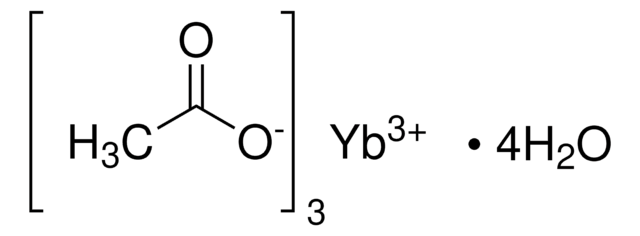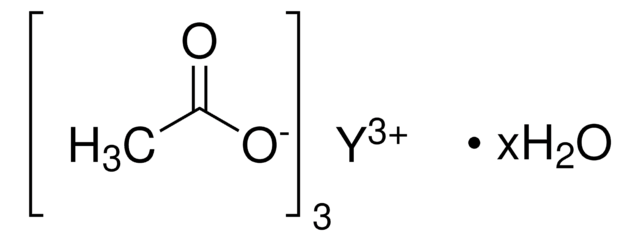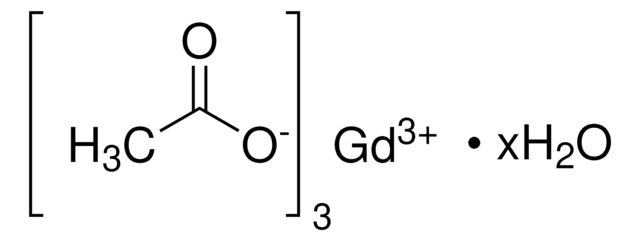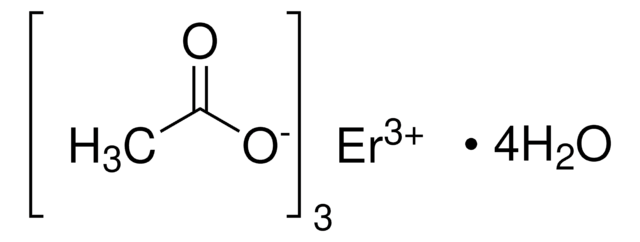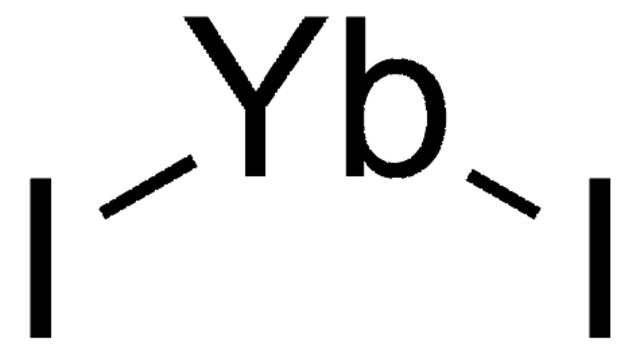544973
Ytterbium(III) acetate hydrate
99.95% trace metals basis
Synonym(s):
Acetic acid ytterbium hydrate
Sign Into View Organizational & Contract Pricing
All Photos(1)
About This Item
Linear Formula:
Yb(C2H3O2)3 · xH2O
Molecular Weight:
350.17 (anhydrous basis)
EC Number:
MDL number:
UNSPSC Code:
12352103
PubChem Substance ID:
NACRES:
NA.23
Recommended Products
Quality Level
Assay
99.95% trace metals basis
form
powder or crystals
reaction suitability
core: ytterbium
reagent type: catalyst
SMILES string
O.CC(=O)O[Yb](OC(C)=O)OC(C)=O
InChI
1S/3C2H4O2.H2O.Yb/c3*1-2(3)4;;/h3*1H3,(H,3,4);1H2;/q;;;;+3/p-3
InChI key
PHWPQNTXTCAARQ-UHFFFAOYSA-K
Application
- Highly luminescent, biocompatible ytterbium (III) complexes as near-infrared fluorophores for living cell imaging: This study highlights the development of ytterbium complexes with enhanced near-infrared luminescence suitable for live-cell imaging, utilizing Ytterbium(III) acetate hydrate as a precursor. The findings demonstrate significant potential for biomedical applications, particularly in imaging techniques sensitive to deeper tissue penetration (Ning et al., 2018).
Storage Class Code
11 - Combustible Solids
WGK
WGK 3
Flash Point(F)
Not applicable
Flash Point(C)
Not applicable
Personal Protective Equipment
dust mask type N95 (US), Eyeshields, Gloves
Choose from one of the most recent versions:
Already Own This Product?
Find documentation for the products that you have recently purchased in the Document Library.
Customers Also Viewed
Aleksandra Kiseleva et al.
ACS applied materials & interfaces, 11(26), 22962-22972 (2019-06-30)
Spider silk is a natural material possessing unique properties such as biocompatibility, regenerative and antimicrobial activity, and biodegradability. It is broadly considered an attractive matrix for tissue regeneration applications. Optical monitoring and potential control over tissue regrowth are attractive tools
Huihui Wang et al.
Talanta, 197, 558-566 (2019-02-18)
A selective, simple and environment-friendly type fluorescence sensing platform between upconversion nanoparticles (UCNPs) and melanin-like polymer utilizing the photoinduced electron-transfer (PET) mechanism was developed. The effective fluorescence quenching of UCNPs by melanin-like polymers could detect tyramine and tyrosinase (TYR) activity
Agnieszka Noculak et al.
Nanotechnology, 28(17), 175706-175706 (2017-03-08)
Three sets of β-NaGdF
Qianqian Su et al.
Frontiers in chemistry, 8, 836-836 (2020-10-24)
Lanthanide-based upconversion nanoparticles can convert low-energy excitation to high-energy emission. The self-assembled upconversion nanoparticles with unique structures have considerable promise in sensors and optical devices due to intriguing properties. However, the assembly of isotropic nanocrystals into anisotropic structures is a
Wei Kong et al.
Inorganic chemistry, 56(2), 872-877 (2017-01-06)
Lanthanide-doped upconversion nanoparticles with a suitable surface coating are appealing for biomedical applications. Because high-quality upconversion nanoparticles are typically prepared in an organic solvent and passivated by hydrophobic oleate ligands, a convenient and reliable method for the surface modification of
Our team of scientists has experience in all areas of research including Life Science, Material Science, Chemical Synthesis, Chromatography, Analytical and many others.
Contact Technical Service